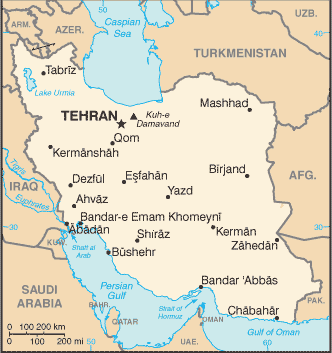A press conference was held today by the Iran Policy Committee (IPC), a group aimed at pressuring the US government to further support Iran’s armed opposition factions, to unveil evidence from one such group, the Mujahedin-e Khalq (MeK) that Iran is secretly developing a major nuclear enrichment site.
 The new site is located near the city of Qazvin and is said to have begun in early 2005. The MeK (which has been fighting for years to get itself removed from the official State Department list of terrorists) released satellite images of the alleged site, but those images don’t appear to be much more than a picture of a mountain range.
The new site is located near the city of Qazvin and is said to have begun in early 2005. The MeK (which has been fighting for years to get itself removed from the official State Department list of terrorists) released satellite images of the alleged site, but those images don’t appear to be much more than a picture of a mountain range.
And while this “revelation,” which is really more of a rumor at this point, is point to spark a series of new panics about Iran’s “secret” activities, the group admits there is no evidence that any centrifuges have been moved to the site, let alone any nuclear material.
Which means Iran is in keeping with its safeguards agreement even if this site turns out to actually exist, as they are only obliged to inform the IAEA of its existence 6 months before the addition of nuclear material. There has been some debate over this matter, as modified code 3.1 would have required them to disclose the existence as soon as they begin construction. Iran never ratified this provision, however, though they were at one point voluntarily complying with it.
Still, Iran has been insisting all along that they intended to create more enrichment sites as part of an effort to be self-sufficient in nuclear fuel production into the future (with plans to solicit bids for a number of additional power plants), so while we can’t confirm the existence of this alleged underground, partially completed building it would be in keeping with Iran’s own stated policy and its own obligations within the safeguards agreement.
At the same time there is no reason to believe any of this is a proliferation threat, as the most recent IAEA report on Iran continued to verify the non-diversion of nuclear material from civilian purposes and the alleged building, still incomplete, would have IAEA inspectors on site months before any nuclear material was introduced.





The MeK is, interestingly, both listed by the State Department as a terrorist organization and its camp in Iraq has received special protection since the occupation of that country by the US. Originally, an integral participant in the Islamic Revolution, it actively participated in the hostage crisis and later split with the Khomayni regime and moved its headquarters to Iraq, where it fought against Iran in the Iraq/Iran war. For many years it has lobbied Congress to obtain support in its objective to overthrow the Iranian regime. Tom Barksdale of the CIA was one of the few voices to warn against the true nature of this group. It has long been one of the main sources for rumors of Iran's nuclear capabilities/aspirations.